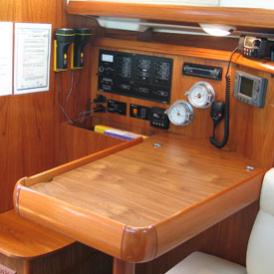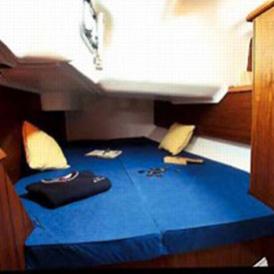Sailing near the Isle of Wight
This was the theme of our company's summer party.A whole day spent at the sea learning to sail and then a yatch race.!!
I was initially skeptical about this idea being much fun as I assumed sailing consisted of putting
the sail up and walking around the yatch holding a glass of wine. But it was not to be, yes the wine was there but sailing was a lot more involved and exciting than initially thought.
We started the day by taking the company bus to Port Solent (Near Portsmouth) to the Yatch Club. The teams consisted of 5-6 people in a Yatch with interesting team names, like Titanic, Love Boat. My team was called the Black Pearl.
After a quick breakfast at the Yatch Club, each team was assigned a skipper (ie one of the several professional sailors from the yatch club). We were given the usual life jackets & wet suits.
Onto the Yatch !!
We were also given a tour of the yatch's "living area" which was pretty well laid out with much more room inside than what appears from the outside. We spend the 1st half hour finding our what each rope on the yatch is called & what it does. (There were atleast 6 ropes with different colours & used to do fancy sounding things).



And just how does a How sailboat sail ??? (Wikipedia)
The energy that drives a sailboat is obtained by manipulating the relative movement of wind and water speed; if there is no difference in movement, such as on a calm day or when the wind and water current are moving in the same direction, there is no energy to be extracted and the sailboat will not be able to do anything but drift. Where there is a difference in motion, then there is energy to be extracted at the interface, and the sailboat does this by placing the sail(s) in the air and the hull(s) in the water.
Sails are foils, and work just like wings do, generating lift using the fluid, in this case air, that flows around them. The curved surface of a sail generates high pressure on the windward side, and low pressure on the lee side, which serves to deflect the air off the trailing edge of the sail. Deflecting the air results in a reaction force on the sail and rigging, which pushes the boat in direction opposite that deflection
Steering and turning
When steering a sailboat, the method for changing direction depends on the direction of the wind. Thus, all direction changes or turns are described by one of the following terms:
* Heading up (or luffing up) means steering so the wind is closer to coming from directly in front (or "on the bow"). Heading closer to the wind requires trimming the sails, pulling them towards the vessel's center. Heading up so the wind is nearly or directly ahead causes sails to luff, to flutter without achieving lift. If the boat loses maneuverability because of this, it is said to be in irons. Tacking (or coming about), one of the basic turning techniques, requires heading up and through the wind so it then comes across the opposite side of the boat, and the boat sails away on the opposite tack.
* Heading down, bearing away, and falling off mean steering so the wind comes from closer to the vessel's aft. This requires easing sails, letting them out away from the vessel's center. Gybing is the turning maneuver in which the boat heads down past the point where the wind crosses the vessel's stern, which causes the sails and boom to swing to the opposite side, before the boat sails off on the opposite tack. The sail crosses with significant speed and misjudged gybing can easily capsize a boat especially in strong winds
Trim
An important aspect of sailing is keeping the boat in "trim". To achieve this a useful mnemonic (memory aid) is the phrase:
Can This Boat Sail Correctly?
This helps the crew to remember these essential points;
* Course to Steer - Turn the boat using the wheel or tiller to the desired course to steer. See points of sail. This may be a definite bearing (e.g steer 270 degrees), or towards a landmark, or at a desired angle to the apparent wind direction.
* Trim - This is the fore and aft balance of the boat. The aim is to adjust the moveable ballast (the crew!) forwards or backwards to achieve an 'even keel'. On an upwind course in a small boat, the crew typically sit forward, when 'running' it is more efficient for the crew to sit to the rear of the boat. The position of the crew matters less as the size (and weight) of the boat increases.
* Balance - This is the port and starboard balance. The aim, once again is to adjust weight 'inboard' or 'outboard' to prevent excessive heeling.
* Sail - Trimming sails is a large topic. Simply put however, a sail should be pulled in until it fills with wind, but no further than the point where the front edge of the sail (the luff) is exactly in line with the wind.
* Centreboard - If a moveable centreboard is fitted, then it should be lowered when sailing "close to the wind" but can be raised up on downwind courses to reduce drag. The centreboard prevents lateral motion and allows the boat to sail upwind. A boat with no centreboard will instead have a heavy permanent keel built into the bottom of the hull, which serves the same purpose.
The 1st half of the day was spent familiarising ourself with the yatch and most of the nautical terms. I also learnt that sailing with the yatch tilting almost into the water was "normal", so was the wild scramble to pull the correct ropes to "tack" into the next section. Keeping the sails "trimmed" did seem like a black art. Even the simple looking job of seeting the yatch to point in the right direction and the best wind was difficult at times.
We sailed around Portsmouth practising our newly found skills and trying to also see the sights around Portsmouth. Yes, Spinnaker tower is fabulous from the sea !!.

We anchored near the Isle of Wight for our Lunch. I managed a few beers as the afternoon was going to be spent racing the other yatchs and did require all of us to be at our nautical best. !!

Racing consisted of sailing as fast as possible between various "gates" in the sea. The gates being an imaginary line drawn between 2 objects (like 2 lighthouses or 2 forts in the sea). When the race started, we found ourselves quite quickly lagging behind the rest of the teams !!. More frantic rope tweaking and wild steering !!

The tacks were becoming more and more professional as the race went by. It was challenge to keep the yatch pointing at the right direction and also maintaing a high speed. In the end the race finished by our team being the 2nd last yatch by doing some smart trignometric calculations between the tacks !!.

Sailing near the Isle of Wight
The evening was spent with dinner and drinks at the yatch club. And the prize giving ceremony. :-(
In all a fantastic fun day out sailing !!



0 Comments:
Post a Comment
<< Home